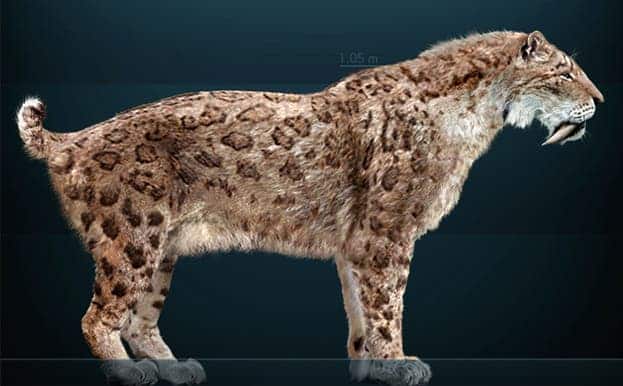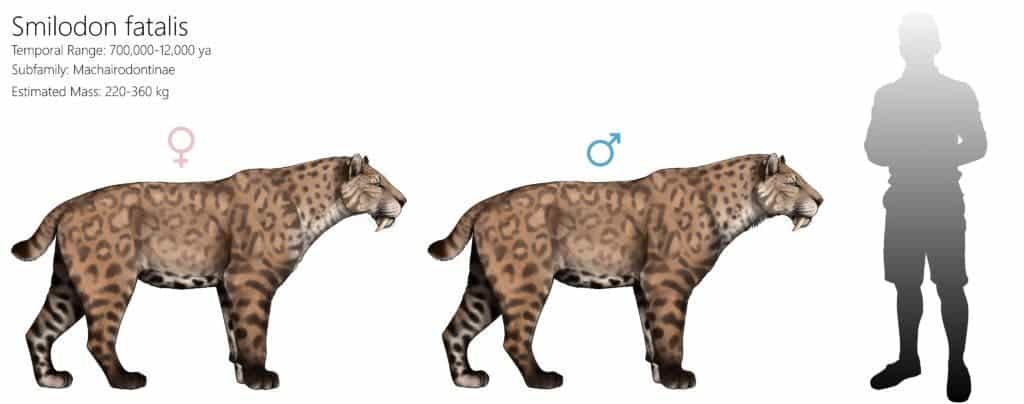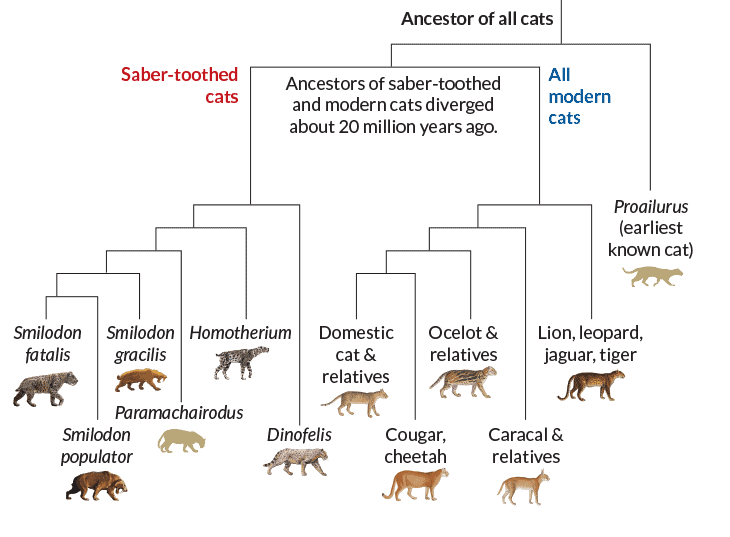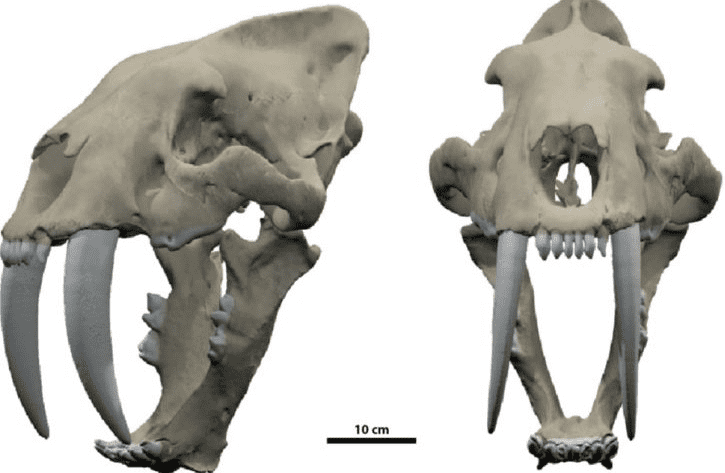
Arguably one of the most famous of all extinct mammals, along with the woolly mammoth, is the fearsome saber-toothed cat, also commonly referred to as saber-toothed tiger. Saber-toothed cats represent a group of fearsome predators that went extinct roughly 12,000 years ago. They are one of the most recognizable megafaunas thanks to their long, curved canine teeth.
Throughout evolutionary history, there were many saber-tooth cats, but for the purpose of this article, we will largely refer to the most successful and widespread member of the Smilodon genus: Smilodon fatalis.
Saber-tooth cat description

One of the largest and best-preserved saber-tooth specimens in the world was recovered from California’s La Brea tar pits. Thanks to the pristine preservation of the fossils, we now have a fairly accurate idea of not only how the giant feline predator looked but also how it must have interacted with its environment during its heyday.
Sabertooths first appeared at least two million years ago, based on the earliest fossils that scientists found, and shared their habitat with the imposing wholly mammoth. Their range extended from most of North and South America. The predators likely lived everywhere from savannahs to steppes, subtropical forests, woodlands, plains, mountains, and more.
Although they’re related to modern cats, sabertooth tigers have no living direct descendants — and that includes tigers, too. Instead, saber-toothed cats belong to a separate subfamily of cats called Machairodontinae, which is totally extinct today. Scientists think Smilodon’s branch diverged from the ancestors of all living cats about 20 million years ago.

Despite their common “nickname”, sabertooth tigers were totally different from tigers. A tiger hunts alone, prowling through the dense vegetation at the twilight in search of prey. When a tiger tracks a tasty target, it will stalk it until it’s within striking range. With a few quick leaps, the tiger’s dinner is secured.
Smilidon fatalis, however, was likely a social animal that hunted in packs, like today’s lions. And although saber-tooth cats may have shared tigers’ stalk-and-pounce hunting style, they were much bulkier, built like bears. This immense physical strength enabled them to take on large prey such as bison.
What’s more, today’s tigers finish off their prey fast — either by quickly breaking their necks or through strangulation. This likely wasn’t the case for saber-tooth cats, whose jaws weren’t built for strangulation or crunching through spines. Instead, the ancient cats used their long, oversized canines to slice and rip through the throats and abdomens of their prey. Severely wounded, the prey would have likely died slowly from hemorrhage rather than suddenly.
Saber-toothed cat mouth

The saber-tooth cats’ mouths are their most recognizable feature. Their distinctive two elongated canines extended past their jaw. Twice as thick from front to back as they were from side to side, these formidable teeth resembled very thick, slightly curved knives. Based on Smilodon fatalis fossils, scientists estimate that adult saber teeth could grow up to 18 centimeters (7 inches) long.
The saber-tooths weren’t born this way, though. Just like humans, they had deciduous baby teeth. Once these came at adolescence, the miniature saber canines steadily grew into huge steak knives at a rate of about 8 millimeters a month for up to 36 months.
In order to accommodate its huge canine teeth without disrupting hunting, the cats had to compensate by drastically enlarging its jaw’s range of motion. A saber-toothed cat could open their mouths up to 120 degrees wide, whereas a lion’s mouth can’t form an angle larger than 60 degrees.
Computer tomography (CT) scans show that the teeth and skulls of the ancient predators were designed to bite into soft flesh and not thick bones. Their neck and jaw muscles also weren’t equipped to hang on to struggling prey for a long time, which is why scientists believe the saber-tooth cat’s strategy was to puncture its prey’s throat or abdomen. Once the prey bled out, the saber-tooth moved in to claim its prize.
Built for raw power
While the saber-toothed cat’s jaw wasn’t built for strength, its body, on the other hand, was a different matter. The cats were incredibly sturdy, almost bear-like with short and powerful legs packing a lot of mass. They definitely didn’t miss leg day!
Though not taller than a modern lion, saber-toothed cats weighed considerably more, tipping the scale at around 300-340 kilograms versus a lion’s typical 220 kilograms. And unlike lions, saber-tooths lacked a long tail. This made them less agile but they made up for it in raw strength.
We don’t know what their fur and coloring were like, but ice age plant fossils suggest that Smilodon had a dappled coat like a cheetah or bobcat, helping it blend with its surroundings.
Saber-tooth cat diet
Smilodon hunted a variety of prey, including bears, horses, young mammoths, ancient bison, prehistoric camels, peccaries, the armadillo-like glyptodonts, and very likely humans. We know their diet thanks to fossils of prey species that have bite patterns that match Silidon’s teeth. Secondly, telltale isotopes preserved in the cat’s bones and teeth provide a second method to establish what the saber-tooth ate.
But, despite their formidable size and menacing teeth, Smilodon wasn’t at the top of its food chain in all its habitats. Some predators that competed with Smilodon for food were the American lion, pumas, lynx, and Miracinonyx.
Smilodon‘s had to be very cautious when hunting not just because of other predators, but also because its saber-teeth were like a double-edged sword. Since they were so delicate, the elongated canines could break easily when pressured with enough force. Most likely, Smilodon was a very wasteful hunter, likely encouraging scavengers to follow the formidable predator in order to have a piece of the kill.
Saber-tooth cat social behavior
The social behavior of the feline predators is a highly debated topic because living in groups is rare among large cats today. Scientists have found the fossils of multiple individuals in close proximity at the La Brea Tar Pits, suggesting that other cats were attracted to the dangerous liquid asphalt when one of them got trapped. This is potential evidence that Smilodon may have lived in groups.
Some saber-tooth cat fossils exhibit signs of trauma, such as broken bones and dislocated hips. The fossils show that these injuries had time to heal. For a solitary hunter, these injuries would have drastically reduced its odds of procuring food, which is why some paleontologists assert that they must have lived in packs. This way, an injured cat could have access to a slice of a freshly killed carcass or gain protection in the face of other predators.
Even if the saber-toothed cats did live in groups, the animals’ exact social structure remains an open question. We know that the typical modern lion pride is comprised of many females and just a few younger males led by an alpha male, who has to constantly compete with the other males for its status. As a result, male lions are much bigger than females in order to be able to defend their position. But despite hundreds of saber-toothed fossils have been analyzed, paleontologists have not found any obvious evidence of size difference between the sexes (sexual dimorphism) in Smilodon.
Why saber-toothed cats went extinct
It’s not clear how these formidable cats went extinct. One hypothesis is that once the bison, Toxodon, or Macrouchenia went extinct — which were likely their favorite prey — so did the saber-toothed cats. The reality is that these cats were hyper-specialized to ambush and overpower large prey. Smaller, faster animals like deer or antelope were likely out of the cat’s reach. Broken Smilodon teeth found among the La Brea fossils suggest that the cats went through very tough times and had to consume entire carcasses including bones — for such a picky eater, that must have been unheard of.
Humans may have also indirectly played a role in the saber-toothed cat’s demise by outcompeting them for food.


